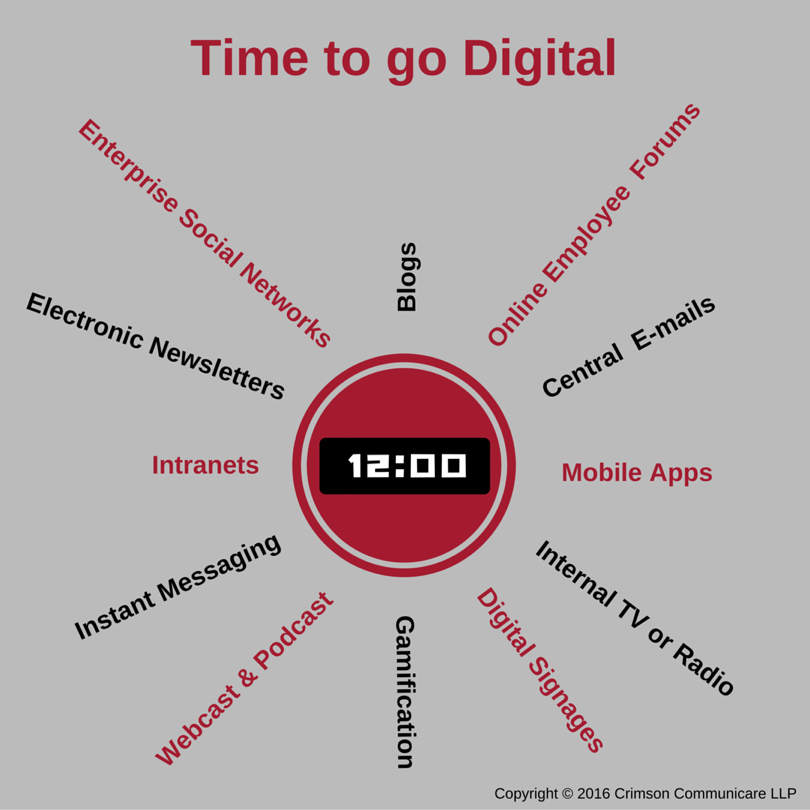Strategic, clear and consistent communication is critical for employee engagement. It helps motivate and empower employees by keeping them informed about an organization’s objectives and the importance of each individual’s role in reaching those goals. Real time communication and option to receive instant feedback are also instrumental in promoting employee engagement.
As organizations grow and start operating in a flat, borderless world, regular and timely communication with their multi-location workforce becomes a huge challenge. The companies need to establish a structure and acquire necessary tools to communicate and collaborate with its entire workforce, regardless of their profile, position, time zone or language.
New age technology is transforming the way companies communicate with their employees. Leading MNCs of the world have standardized their Internal Communication Systems, across all their locations. Many Indian companies have also taken lead in establishing such systems; while many others continue to adopt, experiment and struggle (yes, usually in that order) with multiple digital platforms for employee communications.
But security paranoid IT teams of most Indian organizations have (somewhat justifiably), successfully dodged this digital transformation wave. In the process, they have created a nightmarish situation for us – people responsible for seamless employee communication.
‘Digital Vanilla’ Solutions
Research shows that face-to-face remains the most effective channel for employee communication, compared to print or digital medium. But for a large, multi-location employee base, digital platforms are the most cost-effective solution for real time communication.
Some of the ‘Digital Vanilla’ channels for employee communications are intranet portals, webcasts, digital message boards and instant messaging systems. Use of ‘Social Media’ for employee engagement remains a taboo for most organizations. Many companies, who experimented with Enterprise Social Networking platforms, are still struggling with low adoption and engagement rate.
As a result, for most companies, the preferred mode of internal communication remains – the old and trusted ‘email’.
The E-mail ‘Overloaded’ Employee
Nearly two decade after we dumped pre-printed office memos for emails, for most of us, it still is the easiest and sure-fire way to send out any information to our colleagues.
Over these years, apart from the option of sending out visually attractive html e-mails, this convenient and cost-effective tool has remained devoid of any cutting edge technological breakthrough. What has changed is the several fold increase in the number of emails we send and receive each day. Checking emails, sorting them as critical, important, for action, for information, useless and absolute junk is a sacred ritual, which we repeat several times over during any working day.
Most of the times, it is humanly impossible to keep track of this ‘shock and awe’ bombardment of our mailboxes. In the middle of all this, finding an important piece of information from HR is like finding needle in a haystack.
Ease of sending information through emails has also made us lazy. Hitting the ‘send’ button has a huge sense of accomplishment. We usually have no data on whether the recipient has even opened the mail; leave alone the fact if the recipient has understood the key message or action point.
Maybe it’s time the organizations stop torturing their employees with regular barrage of e-mails and communicate through alternate methods.
The ‘Disconnected’ Employee
Just when organizations are working hard to reduce layers of hierarchy and break the silos, we have another distinct class divide in organizations – The email ‘connected’ and ‘disconnected’ employee. A quick check with your IT team might reveal, that surprisingly high percentage of your co-workers do not have an official email address.
These email ‘disconnected’ employees could be manning the retail counters, doing in-shop demonstrations, working on shop floor or are constantly moving in field for sales, service or delivery. These could also be in-direct or outsourced employees like insurance advisors or cab drivers. Alternatively, the organization might have the view, that the job profile of these employees does not entail regular collaboration with other co-workers.
Providing them individual e-mails or computers can be an impractical or costly proposition. There is also a chance that the ‘disconnected’ employee has an e-mail address and computer, but is unable to regularly access his mails, since he is located in the hinterland with limited Internet coverage.
Whatever be the justification, these ‘disconnected’ employees might not only be dissatisfied, but also lack necessary information needed to properly carry out their functional responsibility. Just like any front-end employees, these people are an organization’s customer touch-points. Their interaction with customers creates ‘moment of truths’ directly impacting the image of the organization. To deliver the brand promise, it is imperative that they receive regular product and training updates from the company.
The ‘Alternates’
Despite multiple challenges, modern workplaces need to be designed for seamless information flow amongst all employees. Furthermore, to have the desired impact of any communication, it needs to be disseminated through multiple channels, simultaneously.

Internal Communication ‘Mobile Apps’
In the past few months, Internal Communication Mobile Apps are creating lots of buzz amongst communication professionals across the world. Though it’s still early days, mobile apps could be instrumental in engaging with both email overloaded and email disconnected employees, due to high penetration rate of smartphones (which is bound to shoot up with Freedom 251) and low data costs in India.
App Options
There are multiple Internal Communication Apps available for instant download compatible with both IOS and Android operating systems. Most can be accessed from multiple Internet connected devices like computers, tablets and phones.
These Apps are designed for one-to-one and one-to-many broadcast of messages, share files, photos and videos and get real time feedback from employees. Additional features may include creation of chat rooms or groups as per your functional needs. A full-service version usually has an absolute ‘must have’ feature – the option to do employee surveys and receive real time analytics on your centralized web console.
Once you overcome the security concerns of your IT team and challenges of slow App adoption rate, you have the power to send real time information or rollout any campaign to your workforce across multiple locations e.g. right from health benefits schemes to product quality updates to emergency communication during a crisis situation.
Readily downloadable Apps usually charge licence fee on ‘per user per month basis’, and are perfect for organizations that have limited employee base. If you have substantial employee strength, it might be more cost-effective to get one developed, specifically for your need, as per your existing IT infrastructure. Furthermore, if developing one from ground-up is a hassle, you can subscribe to a full-service, white-labelled App in your own brand.
If you are willing to spend on an App tailor-made for your organization, you might have the option to broadcast location based offers for your employees e.g. Café Coffee Day or PVR movie gift vouchers for employees based in your Pune plant, valid for the location next to their home. If gamification and contests are your idea of employee engagement, you can have the developer add that feature in your customized App.
Mobile Apps have opened-up a plethora of possibilities to engage email ‘overloaded’ employees and bring in fold the e-mail ‘disconnected’ employees.
And if you have budget constraints, here is a small tip. Some ‘Internal communication Apps’ can provide real time sales analytics and some are ideal for dissemination of training material. So all you need is a buy-in from your Sales or HR head and piggy bank on their expense budget – for free.







At the end of any activity captured thru any communication mode , it may result in revealing an inclusive purpose when it has a qunatifiable qotient relevant to the very revenue model orbit of any entity.Organizations devising way and means to zero down on such quantifications may reveal next set /stage of equilibrium for possible transformations as well. Perhaps an ideal state where all stakeholders are on board .